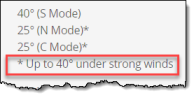When a drone is in a GPS supported mode the drone will not only try to hold position when it hovers... it will also do that when you command any horizontal movement with the sticks.Why would the drone try to fly a straight line without a specific selected course and how does that differentiate from when it IS trying to maintain a course?
Isn't the GPS data only for stability until a waypoint/flight plan programmed?
If you from a hover only command forward flight with the right stick forward... the Flight Controller will only allow a positional change in that direction. If the drone during this forward flight is affected by a wind coming in from the left trying to push the drone to the right, the FC will automatically (without a command from your side) command roll to the left in order to prevent the drone to drift to the right (prevent it to have a uncommanded movement to the right).
In short... the FC will see to that the drone only performs those positional movements that you command with the sticks.
This will work as long as the wind speed is lower than the drone's max available speed... if the wind is faster, the drone will start to drift with the wind with the difference between the wind speed & drone max available speed.
And I write "available speed" for a reason... the drones max speed is in the total tilt direction & not necessarily in the direction you're trying to fly. All "photo drones" are limited by a max tilt angle... if the drone isn't affected by any side winds (the roll angle =0) all tilt can be utilized by pitch if you command full forward flight & the drone will then reach it's maximum speed in the flight direction (if not affected by a head wind, the air speed will be equal to ground speed).
But if the drone also needs to roll to counter a side wind during the forward flight, the max tilt will occur in a direction somewhere between the flight direction & wind direction (called tilt direction)... so in a case like this the drone will not be able to reach the max angle neither in clean pitch or clean roll... so if your drone's specs for instance says max speed = 12m/s & you fly with a strong side wind the drone will not achieve 12m/s in the forward direction... but the air speed in the tilt direction will be 12m/s.
Last edited:











